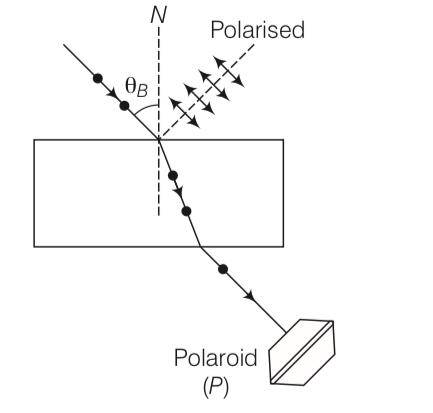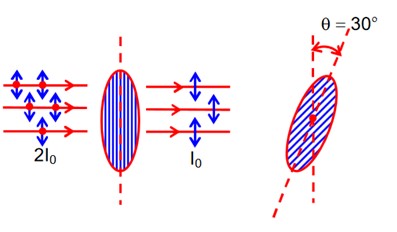Consider a light beam incident from air to a glass slab at Brewster’s angle as shown in figure.
A Polaroid is placed in the path of the emergent ray at point P and rotated about an axis passing through the centre and perpendicular to the plane of the polaroid.
(a) For a particular orientation, there shall be darkness as observed through the polaroid.
(b) The intensity of light as seen through the polaroid shall be independent of the rotation.
(c) The intensity of light as seen through the polaroid shall go minimum but not zero for two orientations of the polaroid.
(d) The intensity of light as seen through the polaroid shall go minimum for four orientations of the polaroid.
Consider a light beam incident from air to a glass slab at Brewster’s angle as shown in figure.
A Polaroid is placed in the path of the emergent ray at point P and rotated about an axis passing through the centre and perpendicular to the plane of the polaroid.
(a) For a particular orientation, there shall be darkness as observed through the polaroid.
(b) The intensity of light as seen through the polaroid shall be independent of the rotation.
(c) The intensity of light as seen through the polaroid shall go minimum but not zero for two orientations of the polaroid.
(d) The intensity of light as seen through the polaroid shall go minimum for four orientations of the polaroid.
-
1 Answer
-
This is a Multiple Choice Questions as classified in NCERT Exemplar
Answer- (c)
Explanation-Consider the diagram the light beam incident from air to the glass slab at Brewster's angle (ip ). The incident ray is unpolarised and is represented by dot (.).
The reflected light is plane polarised represented by arrows.
As the emergent ray is unpolarised, hence intensity cannot be zero when passes through polaroid.

Similar Questions for you
The angle between the plane of vibration and plane of polarization is 90°.
At lower end
Tension, T? = 2g = 20 N (due to the 2 kg block)
Velocity, v? = √ (T? /μ) = √ (20/μ)
Wavelength, λ? = 6 cm
At upper end
Tension, T? = (2 kg + 6 kg)g = 8g = 80 N (due to the block and the rope)
Velocity, v? = √ (T? /μ) = √ (80/μ) = √4 * √ (20/μ) = 2v?
Since frequency (f) remains the same:
f = v? /λ? = v? /λ?
⇒ λ? = λ? * (v? /v? )
⇒ λ? = λ? * (2v? /v? ) = 2λ?
⇒ λ? = 2 * 6 cm = 12 cm
β = λD / (d? + a? sinωt)
β? - β? = λD/ (d? - a? ) - λD/ (d? + a? )
= λD [ (d? + a? ) - (d? - a? ) / (d? ² - a? ²) ]
= 2λDa? / (d? ² - a? ²)
3d = 0.6mm
D = 80cm
= 800mm
Path difference is given by
BP – Andhra Pradesh = Dx
[for Dark fringe at P]
n = 0, for first dark fringe
first dark fringe is observed on the screen directly opposite to one of the slits]
Taking an Exam? Selecting a College?
Get authentic answers from experts, students and alumni that you won't find anywhere else
Sign Up on ShikshaOn Shiksha, get access to
- 65k Colleges
- 1.2k Exams
- 681k Reviews
- 1800k Answers

